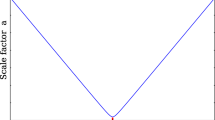Abstract
In quantum cosmological models, constructed in the framework of Friedmann–Robertson–Walker metrics, a nucleation of the Universe with its further expansion is described as a tunneling transition through an effective barrier between regions with small and large values of the scale factor a at non-zero (or zero) energy. The approach for describing this tunneling consists of constructing a wave function satisfying an appropriate boundary condition. There are various ways for defining the boundary condition that lead to different estimates of the barrier penetrability and the tunneling time.
In order to describe the escape from the tunneling region as accurately as possible and to construct the total wave function on the basis of its two partial solutions unambiguously, we use the tunneling boundary condition that the total wave function must represent only the outgoing wave at the point of escape from the barrier, where the following definition for the wave is introduced: the wave is represented by the wave function whose modulus changes minimally under a variation of the scale factor a. We construct a new method for a direct non-semiclassical calculation of the total stationary wave function of the Universe, analyze the behavior of this wave function in the tunneling region, near the escape point and in the asymptotic region, and estimate the barrier penetrability. We observe oscillations of the modulus of the wave function in the external region starting from the turning point which decrease with increasing of a and which are not shown in semiclassical calculations. The period of such an oscillation decreases uniformly with increasing a and can be used as a fully quantum dynamical characteristic of the expansion of the Universe.
Similar content being viewed by others
References
A. Vilenkin, Predictions from quantum cosmology, in Proceedings: String Gravity and Physics at the Planck Energy Scale, ed. by N. Sanchez, A. Zichichi, International School of Astrophysics (NATO Advanced Study Institute), Erice, Italy, 8–19 Sep. 1995. NATO ASI Series C, Mathematical and Physical Sciences, vol. 476 (Kluwer Academic, Dordrecht, 1996), pp. 345–367, 544 p., gr-qc/9507018
B.S. DeWitt, Quantum theory of gravity. I. The canonical theory. Phys. Rev. 160(5), 1113–1148 (1967)
J.A. Wheeler, Batelle Rencontres (Benjamin, New York, 1968)
A. Vilenkin, Creation of universes from nothing. Phys. Lett. B 117(1–2), 25–28 (1982)
J.B. Hartle, S.W. Hawking, Wave function of the Universe. Phys. Rev. D 28(12), 2960–2975 (1983)
A.D. Linde, Quantum creation of the inflationary Universe. Lett. Nuovo Cimento 39(2), 401–405 (1984)
Ya.B. Zel’dovich, A.A. Starobinsky, Quantum creation of a universe in a nontrivial topology. Sov. Astron. Lett. 10(3), 135 (1984)
V.A. Rubakov, Quantum mechanics in the tunneling universe. Phys. Lett. B 148(4–5), 280–286 (1984)
A. Vilenkin, Quantum creation of universes. Phys. Rev. D 30(2), 509–511 (1984)
A. Vilenkin, Boundary conditions in quantum cosmology. Phys. Rev. D 33(12), 3560–3569 (1986)
P.I. Fomin, Dokl. Akad. Nauk Ukr. SSR 9A, 831 (1975)
D. Atkatz, H. Pagels, Origin of the Universe as a quantum tunneling effect. Phys. Rev. D 25(8), 2065–2073 (1982)
A. Vilenkin, Approaches to quantum cosmology. Phys. Rev. D 50(12), 2581–2594 (1994), gr-qc/9403010
V.A. Rubakov, Quantum cosmology, in Proceedings: Structure Formation in the Universe, ed. by R.G. Crittenden, N.G. Turok. (Kluwer Academic, Dordrecht, 1999), pp. 63–74, gr-qc/9910025
J. Ambjorn, J. Jurkiewicz, R. Loll, Semiclassical universe from first principles. Phys. Lett. B 607, 205–213 (2005)
L.D. Landau, E.M. Lifshitz, Quantum Mechanics, Course of Theoretical Physics, vol. 3 (Nauka, Mockva, 1989), p. 768 (in Russian). Eng. variant: Pergamon, Oxford, UK, 1982
S. Weinberg, Gravitatsiya i Kosmologiya: Printsipi i Prilozheniya Obschei Teorii Otnositel’nosti (Mir, Moskva, 1975), 696 p. (in Russian). Eng. variant: S. Weinberg, Gravitation and Cosmology: Principles and Applications of the General Theory of Relativity, MIT, Wiley, New York–London–Sydney–Toronto, 1972
V.A. Rubakov, Introduction to cosmology (RTN Winter School of Strings, Supergravity and Gauge Theories, January 31–February 4 2005, SISSA, Trieste, Italy), 58 p. Available in pos.sissa.it
A. Linde, Particle Physics and Inflationary Cosmology (Harwood, Chur, 1990), 362 p. Contemp. Concepts Phys. 5, hep-th/0503203
M. Trodden, S.M. Carroll, TASI Lectures: Introduction ot cosmology, in Lectures at the Theoretical Advanced Study Institutes in Elementary Particle Physics, ed. by J.M. Maldacena, TASI-2003, Recent Trends in String Theory, University of Colorado at Boulder, 1–27 Jun. 2003 (World Scientific, Singapore, 2005), p. 82, astro-ph/0401547
R.H. Brandenberger, Inflationary cosmology: progress and problems, in Lectures at the International School on Cosmology, Kish Island, Iran, Jan. 22 – Feb. 4 1999 (Kluwer Academic, Dordrecht, 2000), p. 48, hep-ph/9910410
D. Levkov, C. Rebbi, V.A. Rubakov, Tunneling in quantum cosmology: numerical study of particle creation. Phys. Rev. D 66(8), 083516 (2002), gr-qc/0206028
J. Acacio de Barros, E.V. Correa Silva, G.A. Monerat, G. Oliveira-Neto, L.G. Ferreira Filho, P. Romildo Jr., Tunneling probability for the birth of an asymptotically de Sitter universe. Phys. Rev. D 75, 104004 (2007), gr-qc/0612031
V.V. Kuzmichev, Evolution of the quantum Friedmann Universe featuring radiation. Phys. At. Nucl. 62, 708–714 (1999), Yad. Fiz. 62, 758–764 (1999), gr-qc/0002029
V.E. Kuzmichev, V.V. Kuzmichev, Properties of the quantum universe in quasistationary states and cosmological puzzles. Eur. Phys. J. C 23, 337–348 (2002), astro-ph/0111438
M. Abramowitza, I.A. Stegan, Spravochnik po Spetsialnim Funktsiyam s Formulami, Grafikami i Matematicheskimi Tablitsami (Nauka, Moskva, 1979), 832 p. (in Russian). Eng. variant: Handbook of Mathematical Functions with Formulas, Graphs and Mathematical Tables, ed. by M. Abramowitz, I.A. Stegan, National bureau of standards, Applied Math. Series, vol. 55, 1964
Author information
Authors and Affiliations
Corresponding author
Rights and permissions
About this article
Cite this article
Maydanyuk, S.P. Wave function of the Universe in the early stage of its evolution. Eur. Phys. J. C 57, 769–784 (2008). https://doi.org/10.1140/epjc/s10052-008-0723-2
Received:
Revised:
Published:
Issue Date:
DOI: https://doi.org/10.1140/epjc/s10052-008-0723-2




